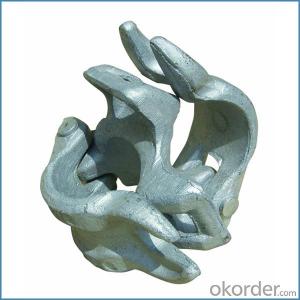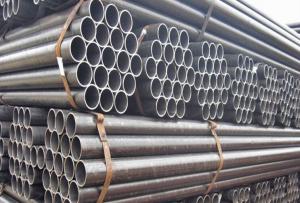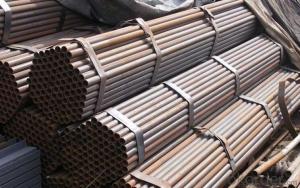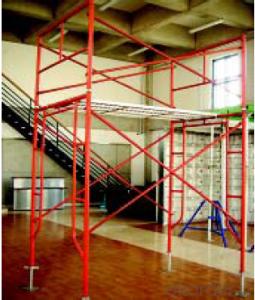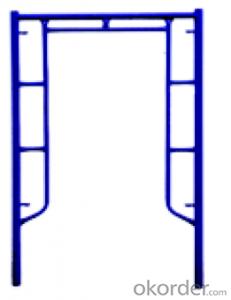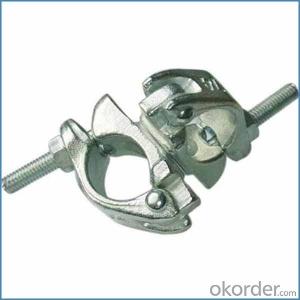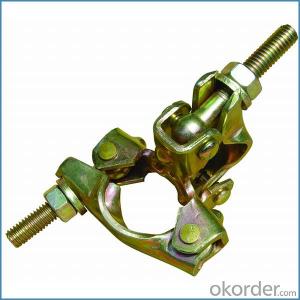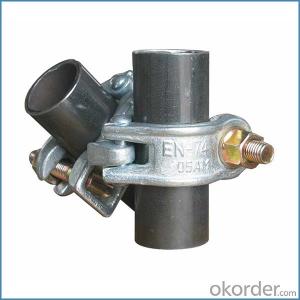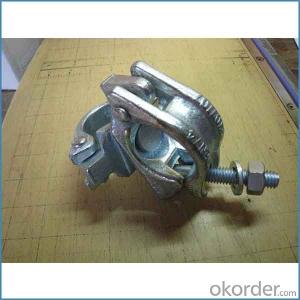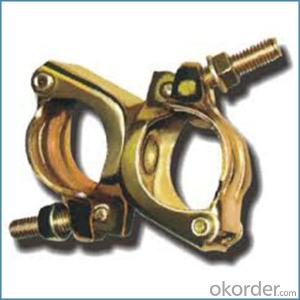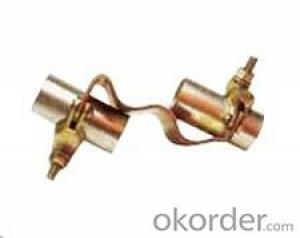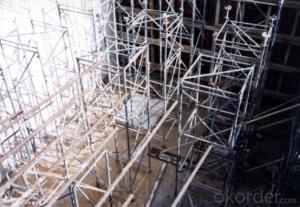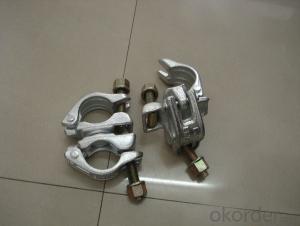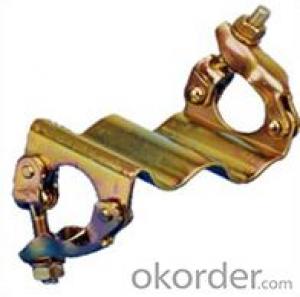Scaffolding Pressed Swivel Coupler British Type for Sale
- Loading Port:
- Tianjin
- Payment Terms:
- TT OR LC
- Min Order Qty:
- 100 kg
- Supply Capability:
- 100000 kg/month
OKorder Service Pledge
OKorder Financial Service
You Might Also Like
Scaffolding Pressed Swivel Coupler British Type for Sale
Description
1.The scaffolding coupler is always used to connect the steel pipe as scaffolding system.
2.The often used coupler is swivel coupler and righ angle coupler .
3.We can provide types of scaffolding coupler according to your requirement.
4.Couoler can fix the 48.3mm scaffolding steel pipe tightly and make the whole scaffolding system more steadily.
5.Material:Q235 steel
6.Overall Size:48.3mm*48.3mm
7.Surface Finish: Galvanized/ Painted
8.Standard:BS1139,EN74
9.Package:25pcs/bag
10.Manufactuering as per customer requirements
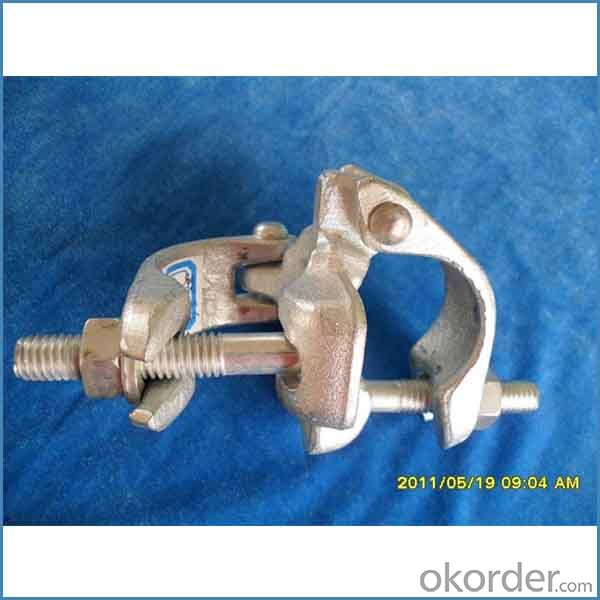
Feature
(1)Excellent Anti-Breaking—Cold Pressed Steel
(2)Outstanding Resistance Deformation
(3)Strong Anti-Dropping Ability
(4)Longtime USe
(5)Qualtity Guaranteed
(6)OEM Service
Photo

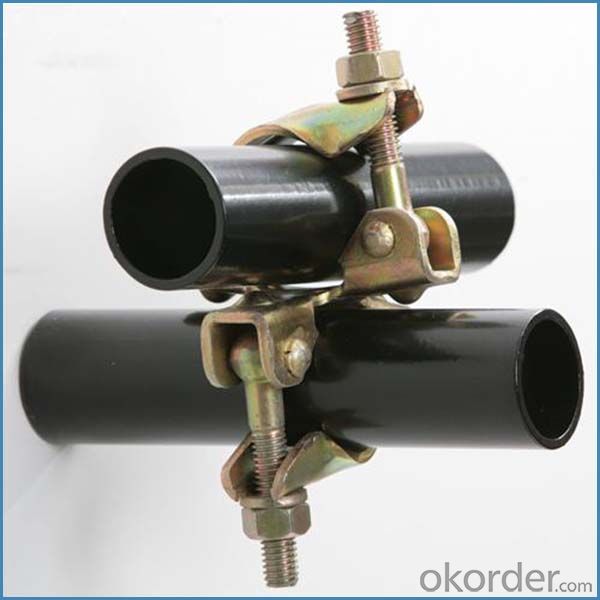
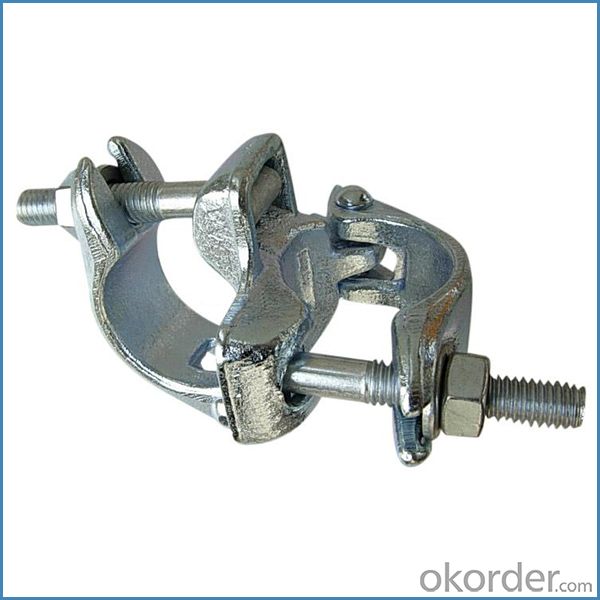
Parameter
| Material | Q235,345steel |
| Size | 48.3mm*48.3mm |
| Surface finish | Galvanized |
| Weight | 1.1kg around |
| Standard | BS1139,EN74 |
| Package | 25pcs/bag,steel pallet |
| Manufacture | As per customer requirement |
| Market | Africa, South America, the Middle East and Asia |
FAQ
Q: Are you a factory or trading company?
We are a state-owned corporation in China,dealing with various kinds of building materials.We have our holding subsidiaries.
Q: Where is your factory located? How can I visit there?
Our factory is located all around China.
Q: Can I get some samples?
Sample is free, customer only pay freight for the first time.
Q: Delivery?
10-30days. (5-15 containers)
Any question,feel free to contact us.
- Q: Are steel tube couplers compatible with scaffolding boards or platforms?
- Yes, steel tube couplers are compatible with scaffolding boards or platforms. Steel tube couplers are designed to connect and secure scaffolding structures, including boards and platforms, ensuring stability and safety during construction or maintenance work.
- Q: Are there any specific considerations for using steel tube couplers in scaffolding that will be used in environments with high levels of humidity or moisture?
- There are specific considerations to take into account when using steel tube couplers in scaffolding that will be used in high humidity or moist environments. To start, it is essential to select steel tube couplers that are specifically designed to resist corrosion. It is highly recommended to use scaffolding couplers made from galvanized or stainless steel as they have a protective layer that prevents rust and corrosion caused by moisture. Galvanized steel couplers have a layer of zinc coating, while stainless steel couplers are made from chromium alloy which offers excellent resistance to corrosion. Furthermore, regular maintenance and inspections are of utmost importance in humid or moist environments. It is crucial to consistently check the scaffolding couplers for any signs of corrosion or damage. If any corrosion is detected, immediate action should be taken to replace the affected couplers in order to ensure the safety and structural integrity of the scaffolding system. In addition, proper storage and handling of the steel tube couplers play a significant role in minimizing exposure to moisture. It is necessary to store the couplers in a dry and well-ventilated area to prevent the accumulation of moisture. During transportation or installation, the couplers should be shielded from rain or water contact to avoid unnecessary exposure to moisture. Moreover, it is advisable to implement additional protective measures such as applying anti-corrosion coatings or using protective caps on the couplers when they are not in use. These measures can offer an extra layer of defense against moisture and help extend the lifespan of the couplers. In conclusion, when using steel tube couplers in scaffolding that will be exposed to high levels of humidity or moisture, it is crucial to select couplers designed for corrosion resistance, conduct regular inspections, properly store and handle the couplers, and consider additional protective measures to ensure their durability and safety.
- Q: Should the staircase be installed in the scaffolding system?
- No. It would add too many points of failure and create a safety hazard.
- Q: What are the common maintenance costs associated with steel tube couplers?
- Common maintenance costs associated with steel tube couplers include regular inspections and replacements of worn or damaged couplers, lubrication of moving parts to prevent friction and corrosion, cleaning and removal of any debris or rust buildup, and occasional welding or repairs for couplers that may have been subjected to excessive stress or force. Additionally, there may be costs associated with training and certification of personnel responsible for maintaining the couplers, as well as the purchase of specialized tools or equipment needed for maintenance tasks. It is important to note that the specific maintenance costs can vary depending on factors such as the frequency of use, environmental conditions, and the quality of the couplers themselves.
- Q: What are the typical dimensions of steel tube couplers used in scaffolding?
- The typical dimensions of steel tube couplers used in scaffolding are around 48.3mm in diameter and have a length of approximately 70mm.
- Q: Are steel tube couplers resistant to compression or crushing forces in scaffolding structures?
- Yes, steel tube couplers are resistant to compression or crushing forces in scaffolding structures. Steel is a strong and durable material that can withstand high amounts of pressure and weight. Couplers are designed to securely connect steel tubes together, providing stability and support to the scaffolding structure. These couplers are manufactured to meet industry standards and are tested for their ability to withstand compression forces. Therefore, steel tube couplers are reliable and capable of withstanding the compression or crushing forces that may be exerted on scaffolding structures.
- Q: How do steel tube couplers ensure proper load transfer and stability in scaffolding structures with varying load requirements?
- Steel tube couplers are an integral component of scaffolding structures that play a crucial role in ensuring proper load transfer and stability, particularly in setups with varying load requirements. These couplers are designed to securely connect steel tubes, creating a strong and stable framework that can withstand different loads and forces. One of the key ways in which steel tube couplers ensure proper load transfer is through their ability to provide a tight and secure connection between the tubes. These couplers are designed with high precision, allowing them to fit tightly around the tubes and create a strong bond. This tight connection ensures that the load applied to one tube is efficiently transferred to the adjacent tubes without any significant loss or displacement. As a result, the load is evenly distributed throughout the scaffold structure, promoting stability and preventing any weak points. Additionally, steel tube couplers are designed to withstand high loads and forces. They are typically made from high-quality steel, which offers excellent strength and durability. This enables the couplers to handle varying load requirements without deformation or failure. Whether the scaffold is subjected to heavy loads or dynamic forces, the steel tube couplers can effectively transfer the load and maintain the stability of the structure. Moreover, steel tube couplers provide versatility in scaffolding structures with varying load requirements. These couplers come in different types and configurations, such as swivel couplers, sleeve couplers, and putlog couplers, among others. This variety allows scaffolding systems to be easily adjusted and adapted to different load conditions. For instance, if a specific section of the scaffold requires additional support or reinforcement due to increased load requirements, additional couplers can be installed to ensure proper load transfer and stability in that particular area. In summary, steel tube couplers ensure proper load transfer and stability in scaffolding structures with varying load requirements through their ability to create tight and secure connections between steel tubes, withstand high loads and forces, and provide versatility in adjusting the scaffold system. By utilizing these couplers, scaffolding structures can effectively distribute the load, maintain stability, and ensure the safety of workers and the integrity of the overall structure.
- Q: Can steel tube couplers be used in specialized scaffolding applications, such as shipbuilding or industrial maintenance?
- Yes, steel tube couplers can be used in specialized scaffolding applications such as shipbuilding or industrial maintenance. Steel tube couplers are versatile and strong, making them suitable for various construction projects, including those in demanding environments like shipyards or industrial facilities. They provide a reliable and secure connection between steel tubes, allowing scaffolding to be erected and dismantled efficiently and safely.
- Q: Are steel tube couplers compatible with both steel and aluminum scaffolding tubes?
- No, steel tube couplers are not compatible with both steel and aluminum scaffolding tubes. Steel tube couplers are specifically designed to be used with steel scaffolding tubes, while aluminum scaffolding tubes require aluminum-specific couplers. This is because steel and aluminum have different properties and strengths, and their couplers are designed to match the specific material they are intended for. Using a steel tube coupler on an aluminum scaffolding tube may result in a compromised connection, which can lead to safety hazards and structural instability. Therefore, it is essential to ensure that the correct couplers are used with the appropriate scaffolding tubes to maintain the integrity and safety of the structure.
- Q: How do you inspect steel tube couplers for any signs of damage or wear?
- To ensure the structural integrity of steel tube couplers and prevent possible accidents or failures, it is crucial to inspect them for signs of damage or wear. The following steps outline an effective approach to inspecting steel tube couplers: 1. Conduct a Visual Inspection: Begin by visually examining the coupler for any noticeable indications of damage or wear. Look for cracks, dents, corrosion, or any other visible abnormalities. Pay close attention to the condition of the surface, edges, and welds. 2. Ensure Cleanliness: Before proceeding with a more detailed inspection, it is important to thoroughly clean the coupler. Remove any dirt, debris, or coatings that may obstruct your view and hinder the identification of potential damage. 3. Utilize Magnifying Tools: Employ magnifying tools, such as a magnifying glass or microscope, to closely examine the coupler's surface. This will assist in identifying small cracks, pitting, or other signs of wear that may be difficult to detect with the naked eye. 4. Consider Non-Destructive Testing: Utilize non-destructive testing techniques, such as ultrasonic or magnetic particle testing, to detect hidden defects and cracks that may not be visible from the surface. 5. Verify Dimensions: Confirm that the coupler's dimensions adhere to the required specifications. Measure the inner and outer diameters, thickness, and length to ensure they align with the manufacturer's guidelines. 6. Conduct Load Testing: If necessary, subject the coupler to load testing to evaluate its strength and structural integrity. This can be achieved by applying a predetermined load and monitoring for any signs of deformation or failure. 7. Document Findings: Maintain thorough documentation of all findings and observations throughout the inspection process. This will facilitate tracking changes or trends over time and assist in making informed decisions regarding maintenance or replacement. 8. Perform Regular Inspections: It is advisable to regularly inspect steel tube couplers, particularly in applications or environments with high levels of stress. Routinely check for signs of wear, corrosion, or any other potential issues to ensure that the couplers remain in optimal condition. By adhering to these steps, you can effectively inspect steel tube couplers and identify any indications of damage or wear. Regular inspections and maintenance will contribute to the safety and durability of the couplers, minimizing the risk of failures or accidents.
Send your message to us
Scaffolding Pressed Swivel Coupler British Type for Sale
- Loading Port:
- Tianjin
- Payment Terms:
- TT OR LC
- Min Order Qty:
- 100 kg
- Supply Capability:
- 100000 kg/month
OKorder Service Pledge
OKorder Financial Service
Similar products
Hot products
Hot Searches
